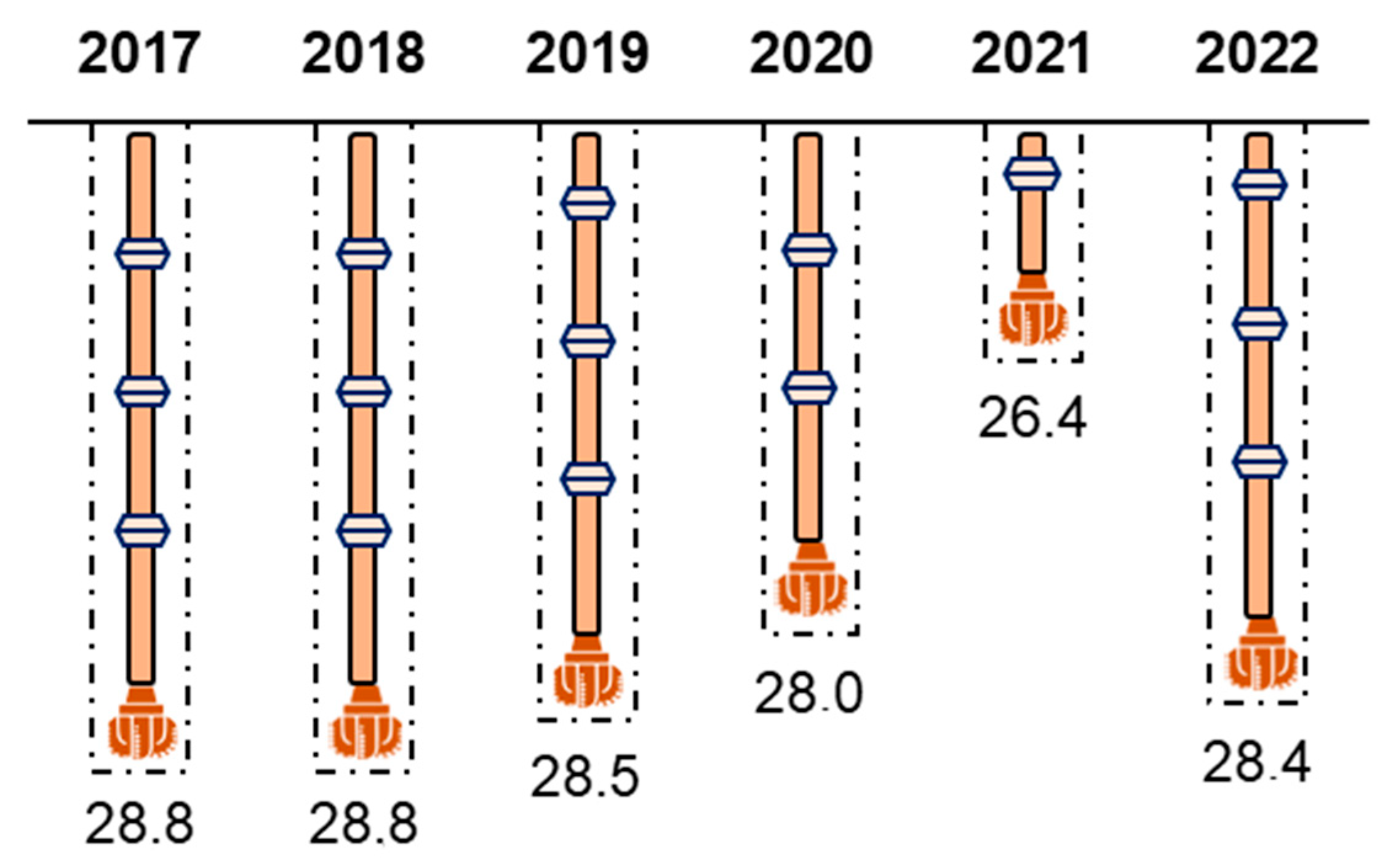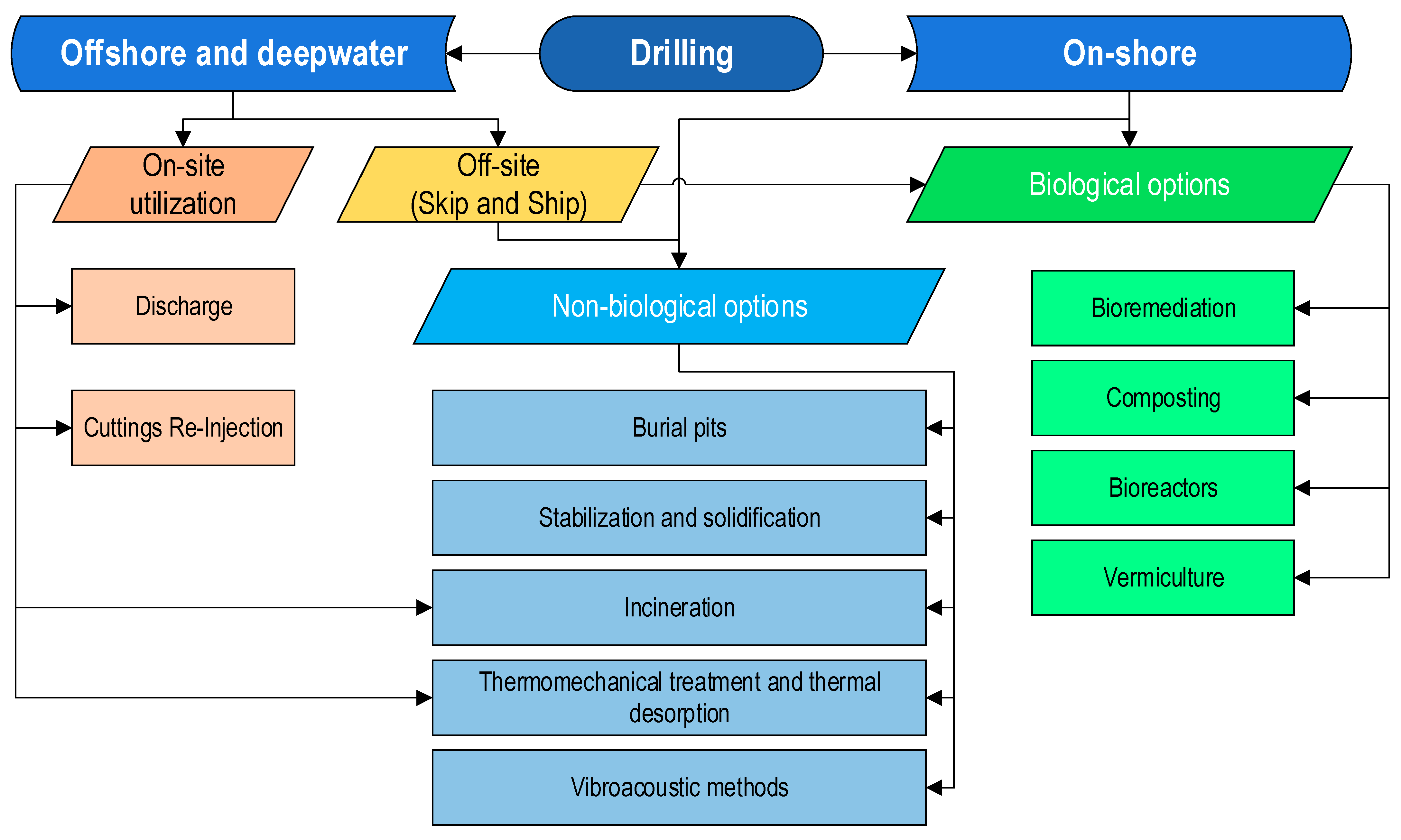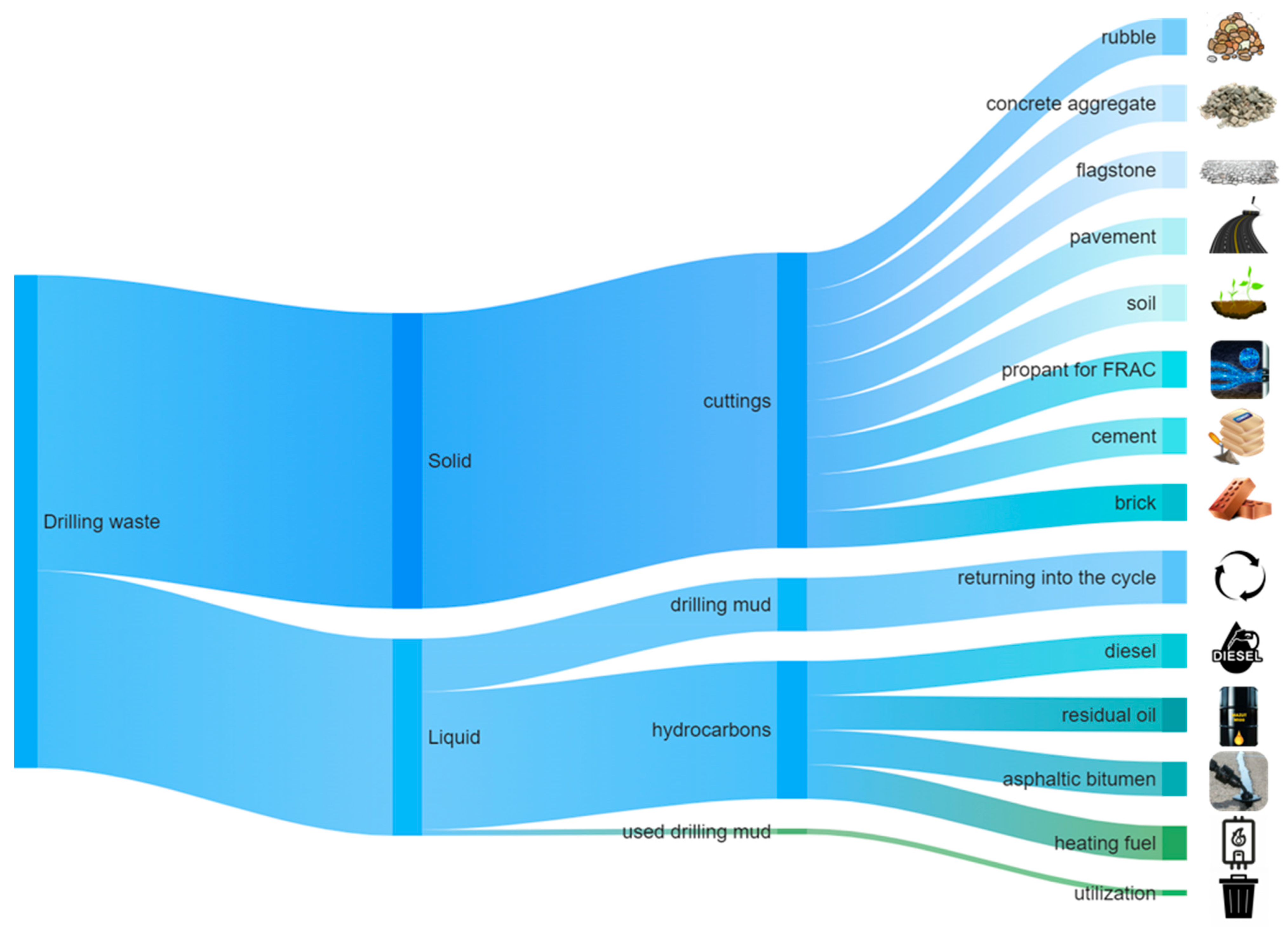Waste Management during the Production Drilling Stage in the Oil and Gas Sector: A Feasibility Study
Abstract
1. Introduction
- Analyze the socio-economic indicators of the Khanty-Mansi Autonomous Okrug and identify the prerequisites for processing drilling waste into construction materials.
- Determine the research methodology and gather initial data necessary for calculations.
- Identify and compare the advantages and disadvantages of the options under analysis.
- Formulate recommendations and suggestions for the development of effective drilling-waste utilization programs.
2. Literature Review
2.1. Current Situation
2.2. Drilling-Waste Disposal Options
2.3. Extension of the Life Cycle of Waste
2.4. Study Object and Market Analysis
- Air pollution from emissions and associated petroleum gas utilization;
- Waste disposal and utilization problems;
- Land and water pollution, including pipeline accidents and improper waste disposal;
- Habitat destruction and negative effects on fauna and flora.
- Infrastructure limitations. Eastern districts, such as Surgut, Nizhnevartovsk, Nefteyugansk, and Khanty-Mansiysk, are the key consumers of construction materials, accounting for 86 to 90% of the total consumption in the region. These districts have better transport accessibility compared to regions with less developed construction materials sectors. Furthermore, remote territories from urbanized centers leads to possible obstacles with the energy supply [80];
- Low labor potential, which, as noted above, is the result of low population density;
- High investments and operating costs compared to the existing production capacities in the southern regions of the Urals and the Siberian Federal District.
3. Materials and Methods
3.1. Utilization Options
- The generated waste is transferred to waste recycling service companies for ownership and use. In the region, there are over 20 service companies that collect, transport, store, and recycle drilling waste [81].
- Waste is disposed of at the drilling site in burial pits. Based on the analysis conducted above, it appears that the number of burial pits is high. This is due to various circumstances, such as economic, technical, technological, and environmental factors, which make it more rational for companies to dispose of waste by constructing burial pits.
3.2. Initial Data and Descriptions
3.2.1. Determination of Production Profile and Number of Wells
3.2.2. Macro Parameters and Fiscal Terms
3.2.3. Capital and Operating Expenditures
3.2.4. Mathematical Representation of the Model—Estimation of Economic Efficiency
4. Results
- Baseline scenario—RUB 18,714.7 million;
- 1st scenario—RUB 17,378.3 million;
- 2nd scenario—RUB 16,954.7 million;
- 3rd scenario—RUB 14,677.1 million.
5. Discussion
6. Conclusions
- Considering the model and given conditions, the most economically effective approach was the fourth scenario, which involves the processing of waste into construction materials with subsequent market sales. The minimum commercial distance and volume of waste were calculated for this option, facilitating the design of the plant’s location and required capacity. Additionally, if waste from a single deposit proves insufficient, combining production facilities from nearby waste sources can expedite the plant’s investment recovery.
- The third scenario also has a potential for realization, as oil and gas field development is a resource-intensive project. The construction of field development facilities requires a large list of both construction materials and energy resources, making it viable to convert drilling waste into materials for road and well pad repairs, fuel, or hydraulic fracturing materials.
- In addition to the economic aspect, the prevented damage and the environmental effect of the implemented measures have been assessed.
- Collaborative efforts between companies and the state can result in tax benefits, reduced rates, subsidies, and other incentives. Based on the research findings, brief proposals for the development of drilling-waste management activities for both companies and the state can be given:
- First of all, when designing oil and gas projects, waste-disposal facilities or sites for their treatment and processing should be included in the construction.
- Possible alternatives for waste utilization should be analyzed based on minimum commercial waste volumes.
- When constructing field development facilities, drilling-waste recycling products should be used.
- It is advisable to issue more regulations covering the use of waste and recycled products and ensure stricter supervision over the licensed activity and use of waste processing and disposal technologies.
Author Contributions
Funding
Data Availability Statement
Conflicts of Interest
References
- Sozina, I.; Danilov, A. Microbiological Remediation of Oil-Contaminated Soils. J. Min. Inst. 2023, 260, 297–312. [Google Scholar] [CrossRef]
- Semenova, T.; Martínez Santoyo, J.Y. Economic Strategy for Developing the Oil Industry in Mexico by Incorporating Environmental Factors. Sustainability 2023, 16, 36. [Google Scholar] [CrossRef]
- Nevskaya, M.A.; Raikhlin, S.M.; Vinogradova, V.V.; Belyaev, V.V.; Khaikin, M.M. A Study of Factors Affecting National Energy Efficiency. Energies 2023, 16, 5170. [Google Scholar] [CrossRef]
- Tsvetkov, P.; Samuseva, P. Heterogeneity of the Impact of Energy Production and Consumption on National Greenhouse Gas Emissions. J. Clean. Prod. 2023, 434, 139638. [Google Scholar] [CrossRef]
- Caenn, R.; Darley, H.C.H.; Gray, G.R. Drilling and Drilling Fluids Waste Management. In Composition and Properties of Drilling and Completion Fluids; Elsevier: Amsterdam, The Netherlands, 2017; pp. 597–636. [Google Scholar]
- Marinina, O.; Kirsanova, N.; Nevskaya, M. Circular Economy Models in Industry: Developing a Conceptual Framework. Energies 2022, 15, 9376. [Google Scholar] [CrossRef]
- Wiesmeth, H.; Starodubets, N.V. The Management of Municipal Solid Waste in Compliance with Circular Economy Criteria: The Case of Russia. Econ. Reg. 2020, 16, 725–738. [Google Scholar] [CrossRef]
- Stroykov, G.; Vasilev, Y.N.; Zhukov, O.V. Basic Principles (Indicators) for Assessing the Technical and Economic Potential of Developing Arctic Offshore Oil and Gas Fields. J. Mar. Sci. Eng. 2021, 9, 1400. [Google Scholar] [CrossRef]
- Seyedmohammadi, J. The Effects of Drilling Fluids and Environment Protection from Pollutants Using Some Models. Model. Earth Syst. Environ. 2017, 3, 23. [Google Scholar] [CrossRef]
- Costa, L.C.; Carvalho, C.F.; Soares, A.S.F.; Souza, A.C.P.; Bastos, E.F.T.; Guimarães, E.C.B.T.; Santos, J.C.; Carvalho, T.; Calderari, V.H.; Marinho, L.S.; et al. Physical and Chemical Characterization of Drill Cuttings: A Review. Mar. Pollut. Bull. 2023, 194, 115342. [Google Scholar] [CrossRef] [PubMed]
- Kornev, A.V.; Spitsyn, A.A.; Korshunov, G.I.; Bazhenova, V.A. Preventing Dust Explosions in Coal Mines: Methods and Current Trends. Min. Informational Anal. Bull. 2023, 3, 133–149. [Google Scholar] [CrossRef]
- Eremeeva, A.M.; Ilyushin, Y.V. Automation of the Control System for Drying Grain Crops of the Technological Process for Obtaining Biodiesel Fuels. Sci. Rep. 2023, 13, 14956. [Google Scholar] [CrossRef]
- Njuguna, J.; Siddique, S.; Bakah Kwroffie, L.; Piromrat, S.; Addae-Afoakwa, K.; Ekeh-Adegbotolu, U.; Oluyemi, G.; Yates, K.; Kumar Mishra, A.; Moller, L. The Fate of Waste Drilling Fluids from Oil and Gas Industry Activities in the Exploration and Production Operations. Waste Manag. 2022, 139, 362–380. [Google Scholar] [CrossRef]
- Leusheva, E.; Alikhanov, N.; Brovkina, N. Study on the Rheological Properties of Barite-Free Drilling Mud with High Density. J. Min. Inst. 2022, 258, 976–985. [Google Scholar] [CrossRef]
- Ukeles, S.D.; Grinbaum, B. Drilling Fluids. In Kirk-Othmer Encyclopedia of Chemical Technology; John Wiley & Sons, Inc.: Hoboken, NJ, USA, 2004. [Google Scholar]
- Breuer, E.; Stevenson, A.G.; Howe, J.A.; Carroll, J.; Shimmield, G.B. Drill Cutting Accumulations in the Northern and Central North Sea: A Review of Environmental Interactions and Chemical Fate. Mar. Pollut. Bull. 2004, 48, 12–25. [Google Scholar] [CrossRef] [PubMed]
- Schaanning, M.T.; Trannum, H.C.; Øxnevad, S.; Carroll, J.; Bakke, T. Effects of Drill Cuttings on Biogeochemical Fluxes and Macrobenthos of Marine Sediments. J. Exp. Mar. Biol. Ecol. 2008, 361, 49–57. [Google Scholar] [CrossRef]
- Baba Hamed, S.; Belhadri, M. Rheological Properties of Biopolymers Drilling Fluids. J. Pet. Sci. Eng. 2009, 67, 84–90. [Google Scholar] [CrossRef]
- Tabatabaee Moradi, S.S.; Nikolaev, N.; Nikolaeva, T. Development of Spacer Fluids and Cement Slurries Compositions for Lining of Wells at High Temperatures. J. Min. Inst. 2020, 242, 174–178. [Google Scholar] [CrossRef]
- Reimers, N.F. Nature Use; Mysl’: Moscow, Russia, 1990; ISBN 5-244-00450-6. (In Russian) [Google Scholar]
- Matytsyn, V. The Concept of Environmental Protection Measures When Drilling Wells. Buren. I Neft 2006, 9, 36–38. (In Russian) [Google Scholar]
- Al Sandouk-Lincke, N.A.; Schwarzbauer, J.; Antic, V.; Antic, M.; Caase, J.; Grünelt, S.; Reßing, K.; Littke, R. Off-Line-Pyrolysis–Gas Chromatography–Mass Spectrometry Analyses of Drilling Fluids and Drill Cuttings—Identification of Potential Environmental Marker Substances. Org. Geochem. 2015, 88, 17–28. [Google Scholar] [CrossRef]
- Tsvetkov, P.; Andreichyk, A.; Kosarev, O. The Impact of Economic Development of Primary and Secondary Industries on National CO2 Emissions: The Case of Russian Regions. J. Environ. Manag. 2024, 351, 119881. [Google Scholar] [CrossRef]
- Golovina, E.; Khloponina, V.; Tsiglianu, P.; Zhu, R. Organizational, Economic and Regulatory Aspects of Groundwater Resources Extraction by Individuals (Case of the Russian Federation). Resources 2023, 12, 89. [Google Scholar] [CrossRef]
- Samylovskaya, E.; Makhovikov, A.; Lutonin, A.; Medvedev, D.; Kudryavtseva, R.-E. Digital Technologies in Arctic Oil and Gas Resources Extraction: Global Trends and Russian Experience. Resources 2022, 11, 29. [Google Scholar] [CrossRef]
- Morero, B.; Paladino, G.L.; Montagna, A.F.; Cafaro, D.C. Integrated Waste Management: Adding Value to Oil and Gas Industry Residues Through Co-Processing. Waste Biomass Valorizat. 2023, 14, 1391–1412. [Google Scholar] [CrossRef]
- Independent Oil and Gas Portal. Available online: https://oilgasinform.ru/ (accessed on 10 June 2023).
- Tsiglianu, P.; Romasheva, N.; Nenko, A. Conceptual Management Framework for Oil and Gas Engineering Project Implementation. Resources 2023, 12, 64. [Google Scholar] [CrossRef]
- Zakirova, G.; Pshenin, V.; Tashbulatov, R.; Rozanova, L. Modern Bitumen Oil Mixture Models in Ashalchinsky Field with Low-Viscosity Solvent at Various Temperatures and Solvent Concentrations. Energies 2022, 16, 395. [Google Scholar] [CrossRef]
- Rosnedra Summed up the Results of Exploration in Russia and 2022 and Outlined the Prospects for Hard to Recover Reserves. Available online: https://neftegaz.ru/news/Geological-exploration/782788-rosnedra-podveli-itogi-grr-v-rossii-i-2022-g-i-oboznachili-perspektivy-triz/ (accessed on 11 June 2023). (In Russian).
- Russian Oil Companies Have Increased the Commissioning of New Wells. Available online: https://www.vedomosti.ru/business/articles/2023/05/04/973682-rossiiskie-neftyaniki-uvelichili-vvodi-novih-skvazhin (accessed on 12 October 2023). (In Russian).
- Drilling Activity in the Russian Oil Sector Remains at a Record Level. Available online: https://neftegaz.ru/news/drill/788717-burovaya-aktivnost-v-neftyanom-sektore-rossii-ostaetsya-na-rekordnom-urovne/ (accessed on 12 October 2023). (In Russian).
- Bulatov, V.; Igenbaeva, N.; Nanishvili, O. Oil and Gas Complex Waste Products as Technological Indicator of Geoecological Condition of Russia Regions. Bull. Sci. Pract. 2021, 7, 46–55. [Google Scholar] [CrossRef]
- State Register of Waste Disposal Facilities. Available online: https://rpn.gov.ru/opendata/7703381225-groro?sphrase_id=1164166 (accessed on 13 June 2023).
- Yang, J.; Sun, J.; Wang, R.; Qu, Y. Treatment of Drilling Fluid Waste during Oil and Gas Drilling: A Review. Environ. Sci. Pollut. Res. 2023, 30, 19662–19682. [Google Scholar] [CrossRef]
- Krapivsky, E.I. Oil Sludge: Destruction, Disposal, Decontamination; Infra-Inzheneriya: Moscow, Russia, 2021; ISBN 978-5-9729-0578-2. (In Russian) [Google Scholar]
- Cherepovitsyn, A.; Lebedev, A. Drill Cuttings Disposal Efficiency in Offshore Oil Drilling. J. Mar. Sci. Eng. 2023, 11, 317. [Google Scholar] [CrossRef]
- Ball, A.S.; Stewart, R.J.; Schliephake, K. A Review of the Current Options for the Treatment and Safe Disposal of Drill Cuttings. Waste Manag. Res. J. A Sustain. Circ. Econ. 2012, 30, 457–473. [Google Scholar] [CrossRef]
- Darajah, M.H.; Karundeng, I.; Setiati, R.; Wastu, A.R.R. Drilling Waste Management Using Zero Discharge Technology with Drill Cutting Re-Injection (DCRI) Method for Environmental Preservation. IOP Conf. Ser. Earth Environ. Sci. 2021, 802, 012046. [Google Scholar] [CrossRef]
- Kirkness, A.; Garrick, D. Treatment of Nonaqueous-Fluid-Contaminated Drill Cuttings—Raising Environmental and Safety Standards. In Proceedings of the IADC/SPE Drilling Conference, Orlando, FL, USA, 4–6 March 2008. [Google Scholar]
- Allen, B.; Day, D.; Armstrong, S.; Page, P.; Murdoch, K.; Beardsley, R. The Development and Trial Use of Oil Exploration Drill-Cutting Waste as an Aggregate Replacement in Cold-Mix Asphalt. In Proceedings of the E&P Environmental and Safety Conference, Galveston, TX, USA, 5–7 March 2007; pp. 293–298. [Google Scholar]
- Durgut, İ.; Rye, H.; Reed, M.; Smit, M.G.D.; Ditlevsen, M.K. Dynamic Modeling of Environmental Risk Associated with Drilling Discharges to Marine Sediments. Mar. Pollut. Bull. 2015, 99, 240–249. [Google Scholar] [CrossRef] [PubMed]
- Saasen, A.; Paulsen, J.E.; Holthe, K. Environmental Priorities of Re-Injection and Land Based Handling of Drilled Cuttings and Affiliated Fluids. In Proceedings of the SPE International Conference on Health, Safety and Environment in Oil and Gas Exploration and Production, Stavanger, Norway, 26–28 June 2000. [Google Scholar]
- Bakke, T.; Klungsøyr, J.; Sanni, S. Environmental Impacts of Produced Water and Drilling Waste Discharges from the Norwegian Offshore Petroleum Industry. Mar. Environ. Res. 2013, 92, 154–169. [Google Scholar] [CrossRef] [PubMed]
- Ling, L.H.; Lye, K.H.; Shern, L.S. Environmentally Sustainable and Cost Effective Offshore Disposal of Drilling Wastes: A Review of Current Practice in Malaysia. In Proceedings of the SPE Asia Pacific Health, Safety, Security, Environment and Social Responsibility Conference, Kuala Lumpur, Malaysia, 4–6 April 2017. [Google Scholar]
- Singh, R.; Budarayavalasa, S. Solidification and Stabilization of Hazardous Wastes Using Geopolymers as Sustainable Binders. J. Mater. Cycles Waste Manag. 2021, 23, 1699–1725. [Google Scholar] [CrossRef]
- Rezaei Somee, M.; Shavandi, M.; Dastgheib, S.M.M.; Amoozegar, M.A. Bioremediation of Oil-Based Drill Cuttings by a Halophilic Consortium Isolated from Oil-Contaminated Saline Soil. 3 Biotech. 2018, 8, 229. [Google Scholar] [CrossRef] [PubMed]
- Arun, J.; Gopinath, K.P.; SundarRajan, P.S.; Felix, V.; JoselynMonica, M.; Malolan, R. A Conceptual Review on Microalgae Biorefinery through Thermochemical and Biological Pathways: Bio-Circular Approach on Carbon Capture and Wastewater Treatment. Bioresour. Technol. Rep. 2020, 11, 100477. [Google Scholar] [CrossRef]
- Kazamias, G.; Zorpas, A.A. Drill Cuttings Waste Management from Oil and Gas Exploitation Industries through End-of-Waste Criteria in the Framework of Circular Economy Strategy. J. Clean. Prod. 2021, 322, 129098. [Google Scholar] [CrossRef]
- Vagapova, E.A.; Ivanov, S.L.; Ivanova, P.V.; Khudyakova, I.N. Hydraulic Miner with Dewatering of Peat in Travelling Magnetic Field. Min. Informational Anal. Bull. 2023, 2023, 21–36. [Google Scholar] [CrossRef]
- Sadiq, R.; Husain, T.; Veitch, B.; Bose, N. Marine Water Quality Assessment of Synthetic-Based Drilling Waste Discharges. Int. J. Environ. Stud. 2003, 60, 313–323. [Google Scholar] [CrossRef]
- Rosa, A.P.; Triguis, J.A. Bioremediation Process on Brazil Shoreline. Environ. Sci. Pollut. Res. Int. 2007, 14, 470–476. [Google Scholar] [CrossRef]
- Carignan, M.-P.; Lake, C.B.; Menzies, T. Assessment of Two Thermally Treated Drill Mud Wastes for Landfill Containment Applications. Waste Manag. Res. J. A Sustain. Circ. Econ. 2007, 25, 394–401. [Google Scholar] [CrossRef]
- OSPAR Discharges, Spills and Emissions from Offshore Oil and Gas Installations in 2009. Including Assessment of Data Reported in 2008 and 2009. Available online: https://oap.ospar.org/en/versions/1884-en-1-0-0-2009-2019/ (accessed on 23 April 2023).
- Ismail, A.R.; Alias, A.H.; Sulaiman, W.R.W.; Jaafar, M.Z.; Ismail, I. Drilling Fluid Waste Management in Drilling for Oil and Gas Wells. Chem. Eng. Trans. 2017, 56, 1351–1356. [Google Scholar] [CrossRef]
- Leonard, S.A.; Stegemann, J.A. Stabilization/Solidification of Petroleum Drill Cuttings: Leaching Studies. J. Hazard. Mater. 2010, 174, 484–491. [Google Scholar] [CrossRef] [PubMed]
- Huang, X.; Peng, X.; Guo, W.; Han, Y.; Zhang, L.; Hou, J.; Yong, Y. Study on Barium Transformation and Environmental Risk during Oil-Based Drill Cuttings Incineration. Res. Environ. Sci. 2023, 36, 1006–1019. [Google Scholar] [CrossRef]
- Zhang, X.; Li, K.; Yao, A. Thermal Desorption Process Simulation and Effect Prediction of Oil-Based Cuttings. ACS Omega 2022, 7, 21675–21683. [Google Scholar] [CrossRef]
- Phillips, L.; Morris, A.; Innes, G.; Clark, A.; Hinden, P.-M. Drilling Waste Management—Solutions That Optimise Drilling, Reduce Well Cost and Improve Environmental Performance. In Proceedings of the Abu Dhabi International Petroleum Exhibition & Conference, Abu Dhabi, United Arab Emirates, 12–15 November 2018. [Google Scholar]
- Fedorov, G.B.; Dudchenko, O.L.; Kurenkov, D.S. Development of Vibroacoustic Module for Fine Filtration of Drilling Muds. J. Min. Inst. 2018, 234, 647–651. [Google Scholar] [CrossRef]
- Weigend Rodríguez, R.; Pomponi, F.; Webster, K.; D’Amico, B. The Future of the Circular Economy and the Circular Economy of the Future. Built Environ. Proj. Asset Manag. 2020, 10, 529–546. [Google Scholar] [CrossRef]
- Resolution of the Government of the Russian Federation of May 31, 2023 No. 881 “On Approval of the Rules for Calculating and Charging Fees for Negative Environmental Impact and on Invalidation of Certain Acts of the Government of the Russian Federation and a Separate Provision of the Act of the Government of the Russian Federation”. Available online: https://www.garant.ru/products/ipo/prime/doc/406865936/ (accessed on 12 October 2023). (In Russian).
- Pichugin, E.A. The Technology of Disposal of Drilling Sludge with the Production of Environmentally Friendly Road-Building Material. Molod. Uchyonyj. Young Sci. 2013, 9, 124–126. (In Russian) [Google Scholar]
- Foroutan, M.; Hassan, M.M.; Desrosiers, N.; Rupnow, T. Evaluation of the Reuse and Recycling of Drill Cuttings in Concrete Applications. Constr. Build. Mater. 2018, 164, 400–409. [Google Scholar] [CrossRef]
- Vlasov, A.S.; Pugin, K.G.; Surkov, A.A. Geoecological Assessment of the Technology for Using Drilling Waste in the Composition of Asphalt-Concrete. Neft. Khozyaystvo Oil Ind. 2020, 2020, 139–142. [Google Scholar] [CrossRef]
- Smyshlyaeva, K.I.; Rudko, V.A.; Kuzmin, K.A.; Povarov, V.G. Asphaltene Genesis Influence on the Low-Sulfur Residual Marine Fuel Sedimentation Stability. Fuel 2022, 328, 125291. [Google Scholar] [CrossRef]
- Khodadadi, M.; Moradi, L.; Dabir, B.; Moghadas Nejad, F.; Khodaii, A. Reuse of Drill Cuttings in Hot Mix Asphalt Mixture: A Study on the Environmental and Structure Performance. Constr. Build. Mater. 2020, 256, 119453. [Google Scholar] [CrossRef]
- Telichenko, V.I.; Oreshkin, D.V. Material Science Aspects of Geo-Ecological and Environmental Safety in Construction. Ecol. Urban. Areas 2015, 2, 31–33. [Google Scholar]
- Oreshkin, D.V. Environmental Problems of Comprehensive Exploitation of Mineral Resources When Large-Scale Utilization of Man-Made Mineral Resources and Waste in the Production of Building Materials. Stroit. Mater. 2017, 8, 55–63. [Google Scholar]
- Disposal of Environmentally Hazardous Drilling Waste. Available online: https://hozuyut.ru/otxody/utilizaciya-ekologicheski-opasnyx-burovyx-otxodov-2.html (accessed on 19 June 2023). (In Russian).
- Tretyak, A.A.; Yatsenko, E.A.; Doronin, S.V.; Borisov, K.A.; Kuznetsova, A.V. Predictive Modeling of Hydraulic Fracturing by Aluminosilicate Proppants Made Based on Drill Cuttings. Bull. Tomsk Polytech. Univ. Geo Assets Eng. 2023, 334, 165–172. [Google Scholar] [CrossRef]
- Samuels, D. Recover and SCS Team on Sustainable Drilling Waste to Fuel Solution. Available online: https://www.scsengineers.com/recover-and-scs-team-on-sustainable-drilling-waste-to-fuel-solution/ (accessed on 19 November 2023).
- Pereira, L.B.; Sad, C.M.S.; da Silva, M.; Corona, R.R.B.; dos Santos, F.D.; Gonçalves, G.R.; Castro, E.V.R.; Filgueiras, P.R.; Lacerda, V. Oil Recovery from Water-Based Drilling Fluid Waste. Fuel 2019, 237, 335–343. [Google Scholar] [CrossRef]
- Dmitrieva, D.; Solovyova, V. Russian Arctic Mineral Resources Sustainable Development in the Context of Energy Transition, ESG Agenda and Geopolitical Tensions. Energies 2023, 16, 5145. [Google Scholar] [CrossRef]
- De Almeida, P.C.; Araújo, O.D.Q.F.; de Medeiros, J.L. Managing Offshore Drill Cuttings Waste for Improved Sustainability. J. Clean. Prod. 2017, 165, 143–156. [Google Scholar] [CrossRef]
- Volkov, I.N.; Gokhberg, L.M.; Drobysheva, M.A.; Zubarevich, N.V.; Klimanov, V.V.; Kuznetsova, O.V.; Kukushkin, A.M.; Petrenko, A.V.; Skatershchikova, E.E.; Khoreva, L.A. (Eds.) Regions of Russia. Socio-Economic Indicators. 2022: P32 Statistical Collection; Rosstat: Moscow, Russia, 2022. (In Russian) [Google Scholar]
- The Strategy of Socio-Economic Development of the Khanty-Mansiysk Autonomous Okrug—Yugra until 2020 and for the Period 2030. Part 7. Construction Complex. Available online: https://depeconom.admhmao.ru/upload/iblock/077/stroitelnyy.pdf (accessed on 21 June 2023). (In Russian).
- Analysis of the Construction Materials Market in Khanty-Mansiysk Autonomous Okrug—Yugra | Regional Analytical Center. Available online: https://racugra.ru/wp-content/uploads/2019/04/StrojMaterialy.pdf (accessed on 21 June 2023). (In Russian).
- Problems of Drilling Waste Disposal in Khanty-Mansiysk Autonomous Okrug—Yugra. Available online: https://prirodnadzor.admhmao.ru/doklady-i-otchyety/otchety-o-deyatelnosti-prirodnadzora/teksty-vystupleniy-i-prezentatsii/arkhiv/2012-2015/133061/problemy-utilizatsii-otkhodov-bureniya-v-khanty-mansiyskom-avtonomnom-okruge-yugre/ (accessed on 21 June 2023). (In Russian).
- Lebedev, V.; Deev, A. Heat Storage as a Way to Increase Energy Efficiency and Flexibility of NPP in Isolated Power System. Appl. Sci. 2023, 13, 13130. [Google Scholar] [CrossRef]
- Razmanova, S.; Andrukhova, O. Oilfield Service Companies as Part of Economy Digitalization: Assessment of the Prospects for Innovative Development. J. Min. Inst. 2020, 244, 482–492. [Google Scholar] [CrossRef]
- Rosneft Applied an Innovative Method of Drilling Waste Utilisation in Yugra. Available online: https://www.rosneft.ru/press/news/item/187683/ (accessed on 20 September 2023). (In Russian).
- A Drilling Sludge Processing Line Has Been Built at the Vankor Field. Available online: https://lenta.ru/news/2023/09/26/shlam/ (accessed on 16 October 2023). (In Russian).
- Shandrygin, A.N. Evaluation of Recoverable Hydrocarbon Reserves. Do We Need to Reinvent the Wheel? Actual Probl. Oil Gas 2019, 4, 10. [Google Scholar] [CrossRef]
- Eder, I.; Filimonova, I.; Mishenin, A.; Mochalov, R. Forecast of Oil Production in Eastern Siberia and On the Far East: Methodologi-Cal Aspects, Practical Realization, The Sanctions Impacting. Buren. I Neft 2014, 12, 10–15. [Google Scholar]
- Ampilov, Y.P.; Gert, A.A. Economic Geology; Geoinformmark: Moscow, Russia, 2006; ISBN 5-98877-010-X. (In Russian) [Google Scholar]
- Zheltov, Y.P. Development of Oil Fields; Nedra: Moscow, Russia, 1986. (In Russian) [Google Scholar]
- Shapovalova, D.; Galimullin, E.; Grushevenko, E. Russian Arctic Offshore Petroleum Governance: The Effects of Western Sanctions and Outlook for Northern Development. Energy Policy 2020, 146, 111753. [Google Scholar] [CrossRef]
- Marin, E.A.; Ponomarenko, T.V.; Vasilenko, N.V.; Galevskiy, S.G. Economic Evaluation of Projects for Development of Raw Hydrocarbons Fields in the Conditions of the Northern Production Areas Using Binary and Reverting Discounting. Sev. I Rynok Form. Ekon. Porad. 2022, 25, 144–157. [Google Scholar] [CrossRef]
- Cochrane, J.H. Presidential Address: Discount Rates. J. Financ. 2011, 66, 1047–1108. [Google Scholar] [CrossRef]
- Ponomarenko, T.; Marin, E.; Galevskiy, S. Economic Evaluation of Oil and Gas Projects: Justification of Engineering Solutions in the Implementation of Field Development Projects. Energies 2022, 15, 3103. [Google Scholar] [CrossRef]
- Mishustin, M.V. Factors of Growth of Tax Revenues: A Macroeconomic Approach. Econ. Policy 2016, 11, 8–27. [Google Scholar] [CrossRef]
- Kuzmenkov, S.G.; Korolev, M.I.; Novikov, M.V.; Palyanitsina, A.N.; Nanishvili, O.A.; Isaev, V.I. Efficiency of Enhanced Oil Recovery’s and Oil Production Stimulation’s Methods at the Oil Fields of Khanty-Mansi Autonomous Okrug—Yugra. Georesursy 2023, 25, 129–139. [Google Scholar] [CrossRef]
- Sardanashvili, O.N.; Bogatkina, Y.G. Technical and Economic Assessment of the Development of the Sredne-Nazym Oil Field Using Various Tax Mechanisms. Neftegaz. Ru 2023, 7. (In Russian) [Google Scholar]
- Bogatkina, Y.G.; Lyndin, V.N.; Eremin, N.A. Information and Economical Approach for Evaluating Oil and Gas Investment Projects. News Tula State Univ. Sci. Earth 2020, 3, 335–346. [Google Scholar] [CrossRef]
- Ryabova, E.V.; Feruleva, N.V.; Zamotaeva, O.A. Assessing the Investment Attractiveness of Oil Field Development Projects under the Tax Maneuver: The Evidence from West Siberia. Financ. J. 2022, 14, 86–101. [Google Scholar] [CrossRef]
- Duryagin, V.; Nguyen Van, T.; Onegov, N.; Shamsutdinova, G. Investigation of the Selectivity of the Water Shutoff Technology. Energies 2022, 16, 366. [Google Scholar] [CrossRef]
- Bogdanova, O.; Okmynskaia, V. Experience in the Implementation of Drilling Waste Utilization Technology on the Example of a Large Oil and Gas Region of Russia. J. Ecol. Eng. 2022, 23, 132–139. [Google Scholar] [CrossRef] [PubMed]
- Decree of the Government of the Russian Federation, No. 913 of September 13, 2016 “On the Rates of Payment for Negative Environmental Impact and Additional Coefficients”. Available online: http://ivo.garant.ru/#/document/71489914/paragraph/1:2 (accessed on 19 June 2023). (In Russian).
- The Project of Reclamation of Lands Violated in Connection with The Arrange-Ment of Drilling Mud Barns and Lands Violated in Connection with The Arrange-Ment of Exploration Wells of JSC “Samotlorneftegaz”. Available online: https://clck.ru/36LL5v (accessed on 3 November 2023). (In Russian).
- Processing Of Drilling Waste in Offline Mode with the Use of a Filter Press In-Stallation. Available online: https://www.ecoindustry.ru/i/ent/903/presentation_14531229335228.pdf (accessed on 3 November 2023). (In Russian).
- Arrangement of the Cluster Site, No. 81 of the Srednebotuobinsky Oil and Gas Condensate Field. Available online: https://botuobuia.sakha.gov.ru/uploads/905/f09527c89184cfcb887e470b01007a4b58170f67.pdf (accessed on 3 November 2023). (In Russian)
- Anofriev, S.S. Construction of a Drilling Sludge Disposal Plant at the Samotlorskoye Field; South Ural State University: Nizhnevartovsk, Russia, 2020. (In Russian) [Google Scholar]
- Methodology for Calculating the Amount of Damage Caused to Soils as an Object of Environmental Protection. Available online: https://docs.cntd.ru/document/902227668?marker=6500IL (accessed on 8 November 2023). (In Russian).
- Siddique, S.; Novak, A.; Guliyev, E.; Yates, K.; Leung, P.S.; Njuguna, J. Oil-Based Mud Waste as a Filler Material in LDPE Composites: Evaluation of Mechanical Properties. Polymers 2022, 14, 1455. [Google Scholar] [CrossRef] [PubMed]
- Stroykov, G.A.; Babyr, N.V.; Ilin, I.V.; Marchenko, R.S. System of Comprehensive Assessment of Project Risks in the Energy Industry. Int. J. Eng. 2021, 34, 1778–1784. [Google Scholar] [CrossRef]
- Yudin, S.S.; Cherepovitsyn, A.E. Partnership between Government and Business to Ensure the Economic Sustainability of Complex Industrial Oil and Gas Systems in the Arctic. Sev. I Rynok Form. Ekon. Porad. 2022, 25, 7–18. [Google Scholar] [CrossRef]
- Malyshkov, G.B.; Nikolaichuk, L.A.; Sinkov, L.S. Legislative Regulation of Waste Management System Development in Russian Federation. Int. J. Eng. Res. Technol. 2019, 12, 631–635. [Google Scholar]
- Belov, V. Special Investment Contracts and Russian-German Economic Cooperation. Part Two. Contemp. Eur. 2020, 1, 146–157. [Google Scholar] [CrossRef]
- Bykowa, E.; Skachkova, M.; Raguzin, I.; Dyachkova, I.; Boltov, M. Automation of Negative Infrastructural Externalities Assessment Methods to Determine the Cost of Land Resources Based on the Development of a “Thin Client” Model. Sustainability 2022, 14, 9383. [Google Scholar] [CrossRef]
- Syasko, V.; Shikhov, A. Soil Deformation Model Analysis in the Processing of the Geotechnical Monitoring Results. E3S Web Conf. 2021, 266, 03014. [Google Scholar] [CrossRef]
- Syas’ko, V.; Shikhov, A. Assessing the State of Structural Foundations in Permafrost Regions by Means of Acoustic Testing. Appl. Sci. 2022, 12, 2364. [Google Scholar] [CrossRef]
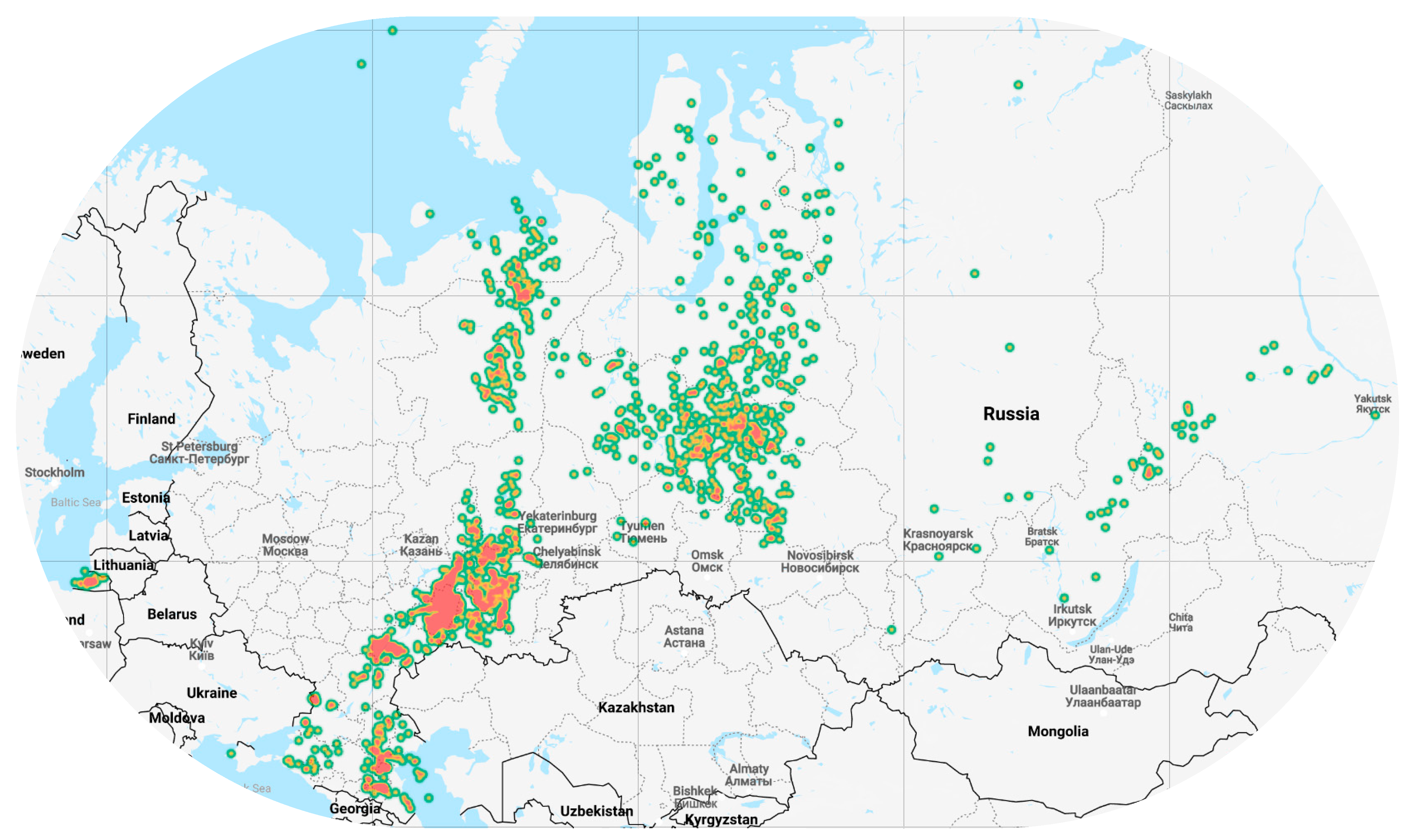


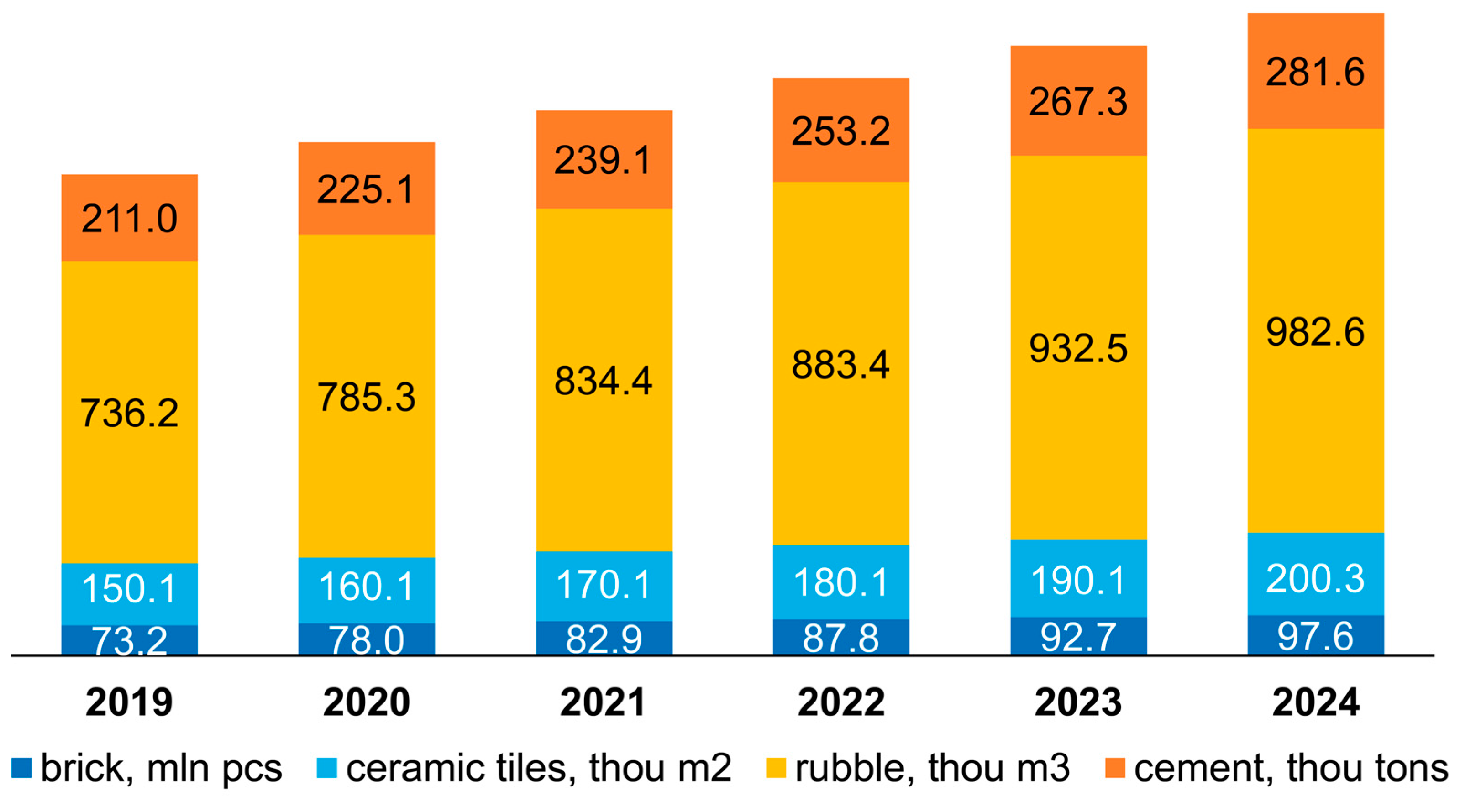

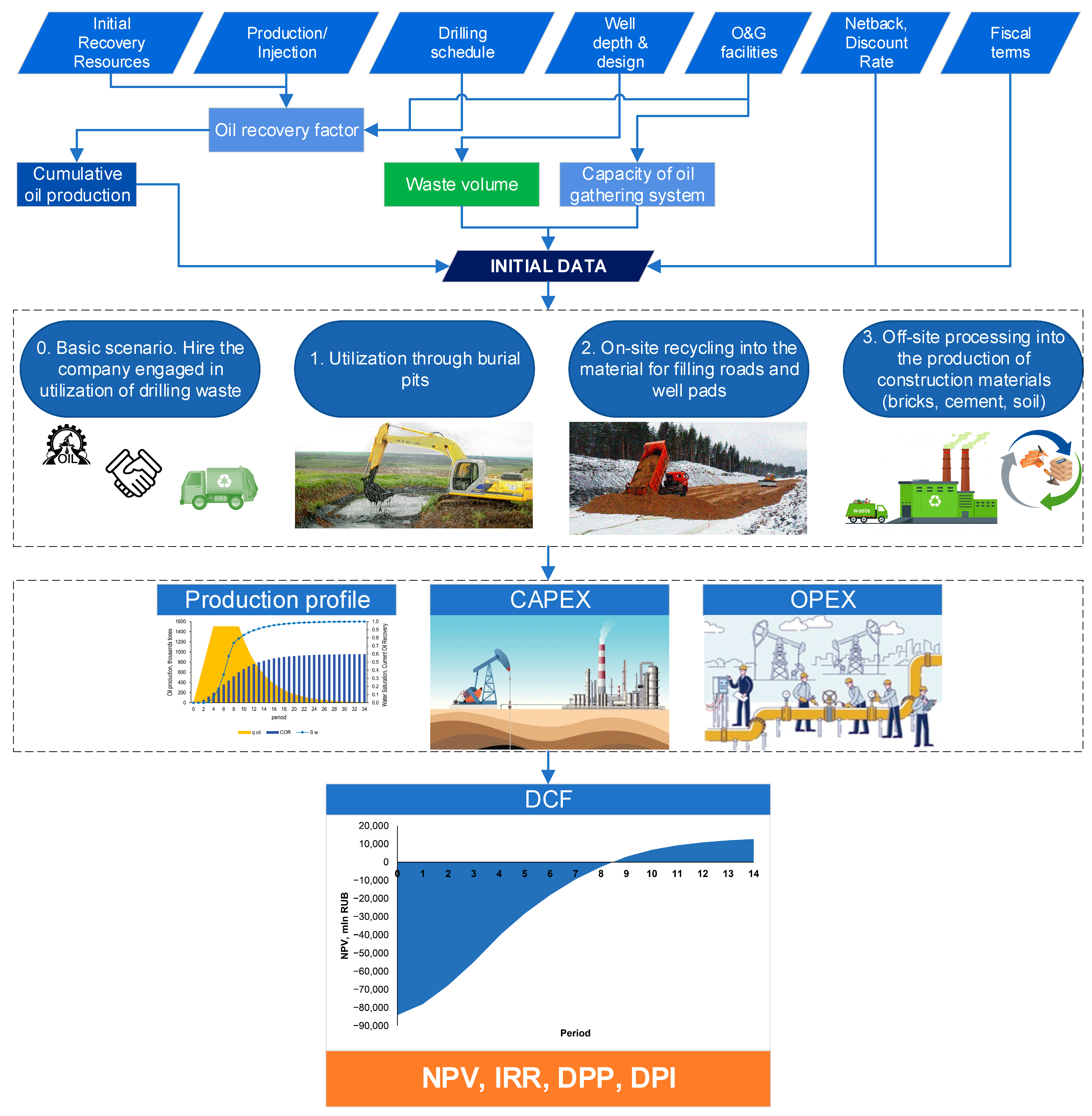

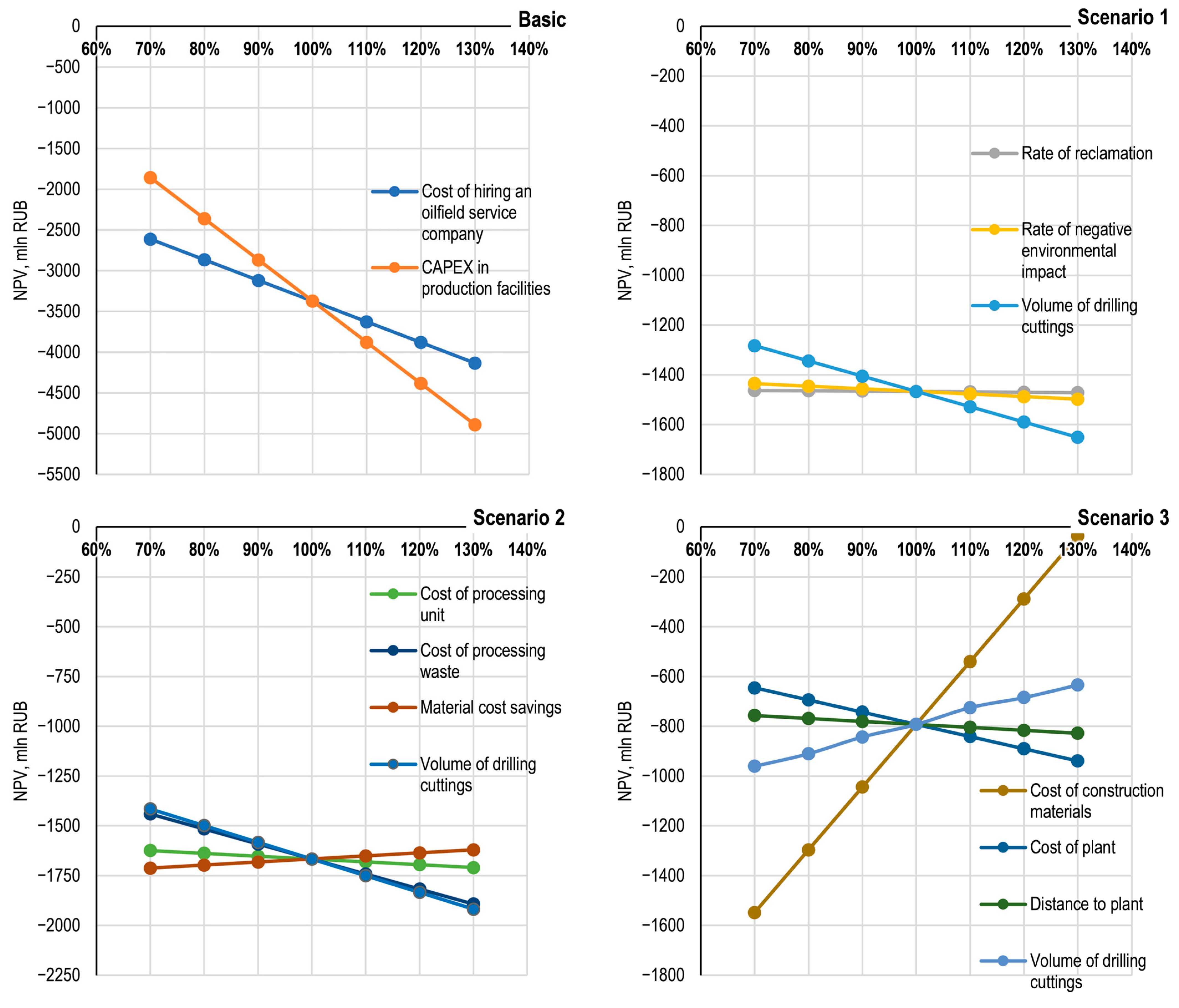
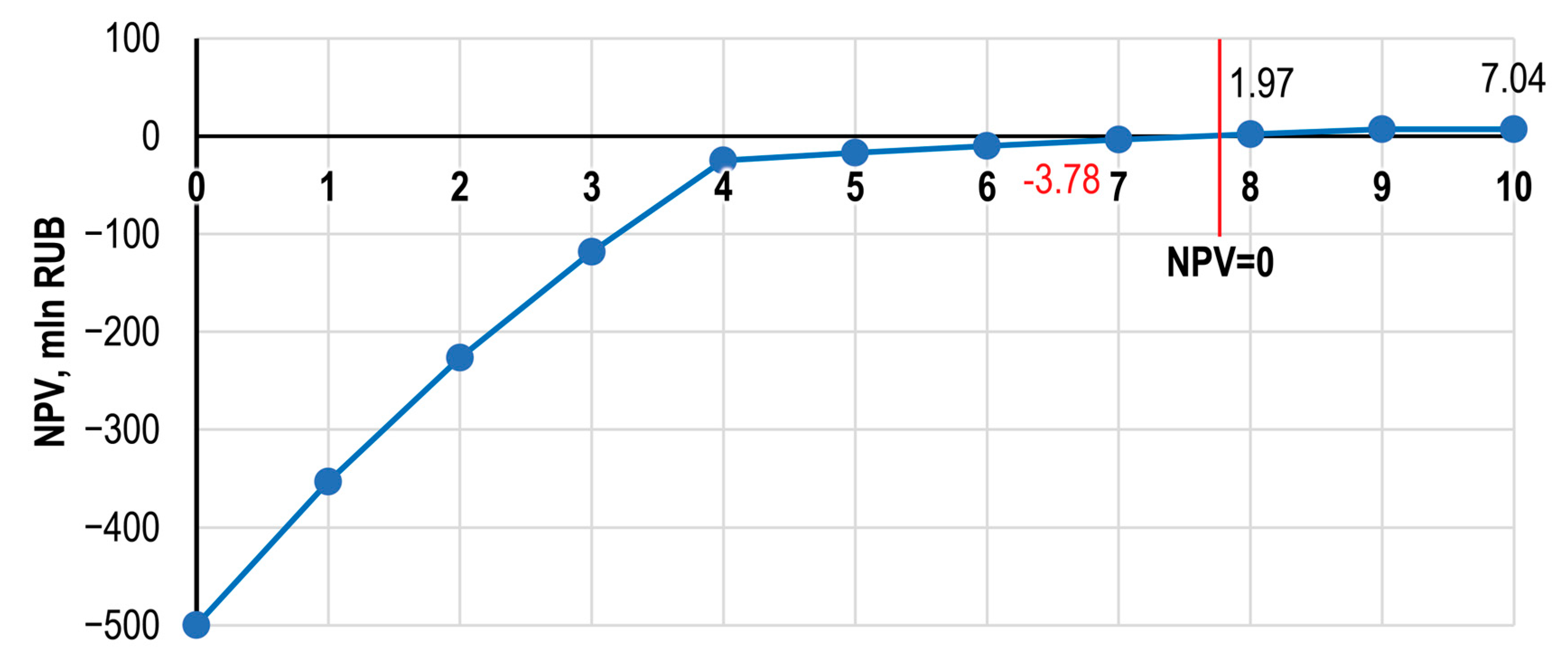
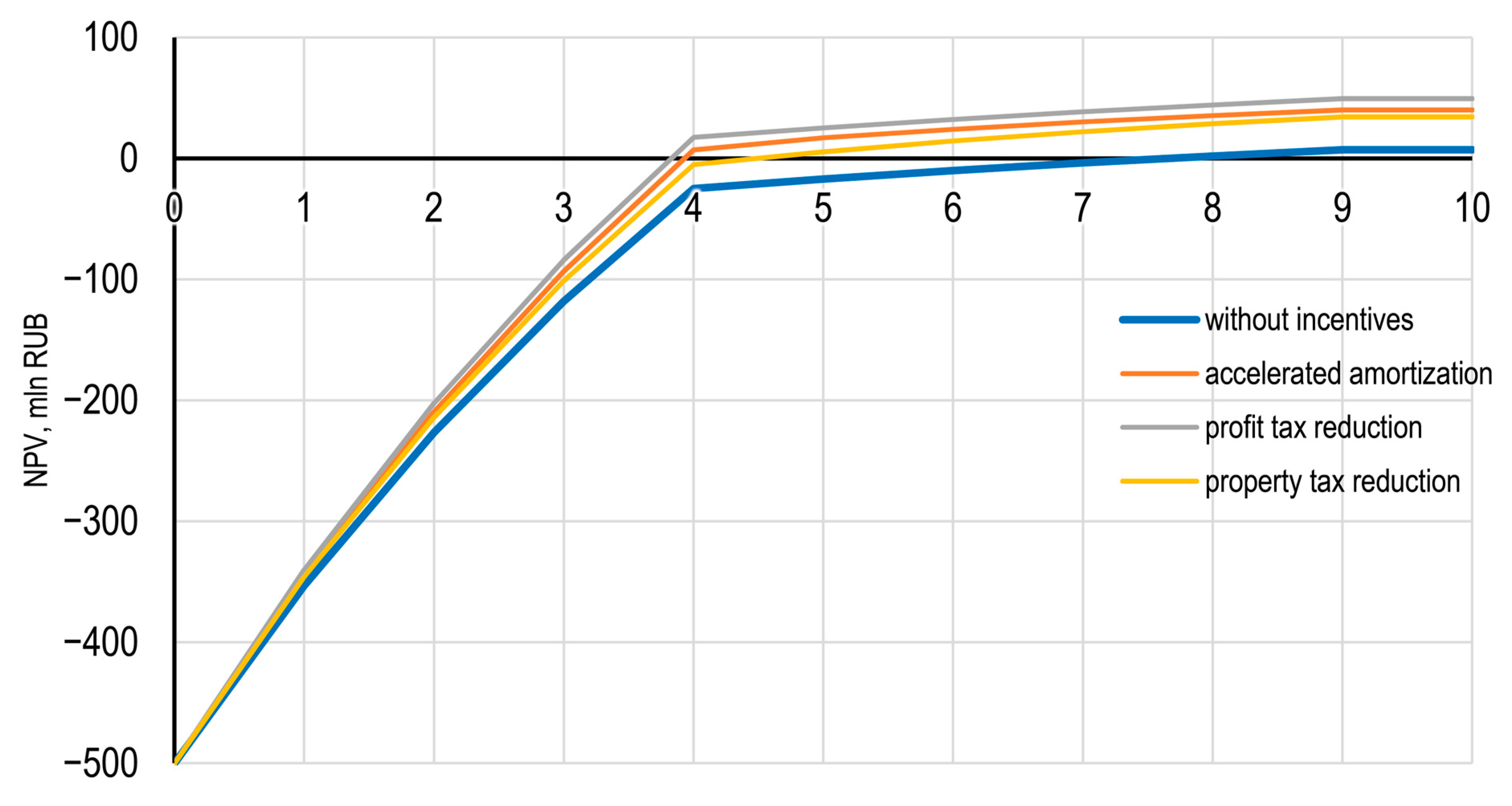
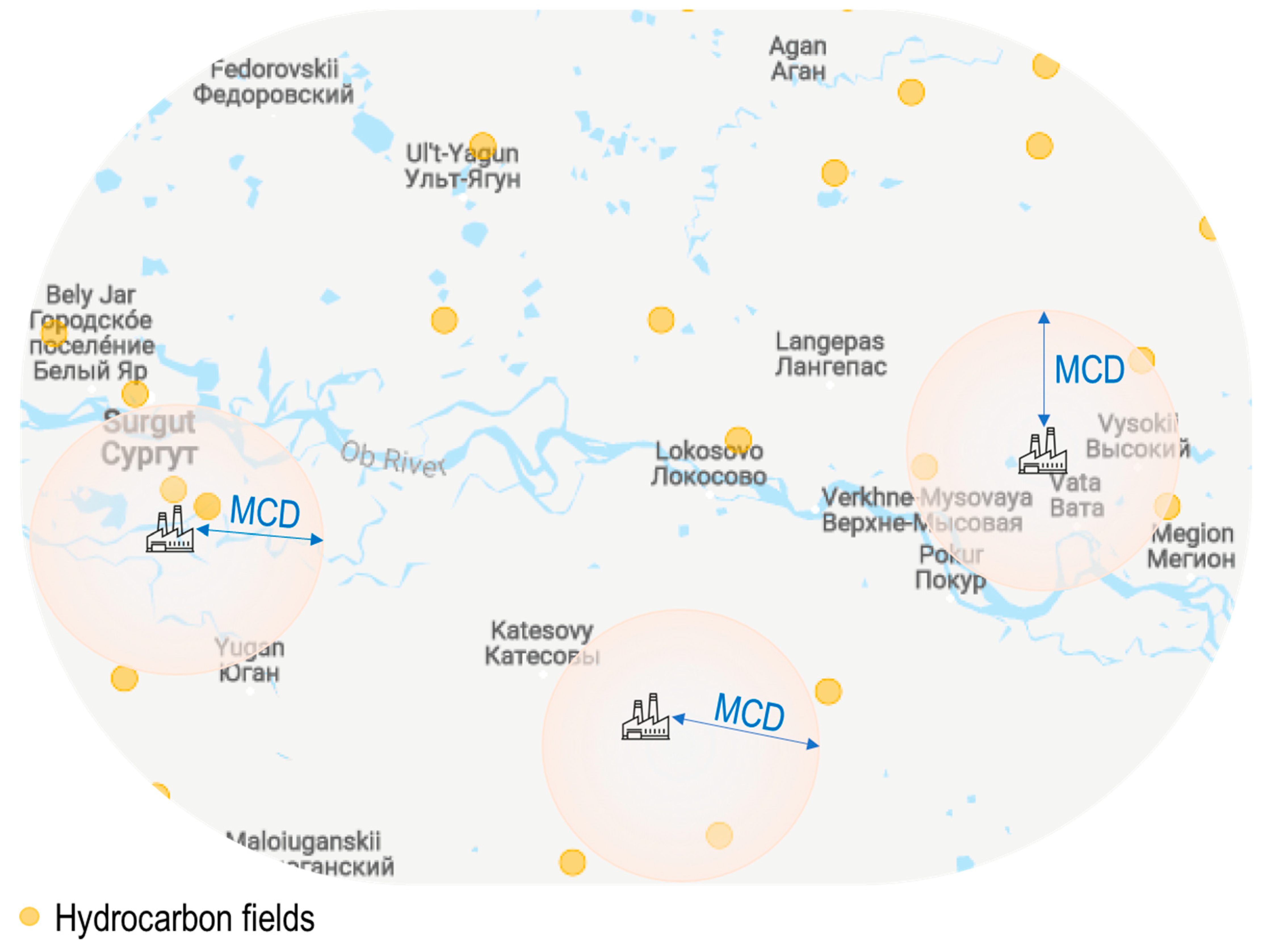
| Method | Advantages | Disadvantages | Limitations | Source |
|---|---|---|---|---|
| Discharge |
|
|
| [42,54] |
| Cutting re-Injection |
|
|
| [37,39,49] |
| Burial pits |
|
|
| [13,46,55] |
| Stabilization and solidification |
|
|
| [46,56] |
| Incineration |
|
|
| [57] |
| Thermomechanical treatment and thermal desorption |
|
|
| [37,49,58,59] |
| Vibroacoustic methods |
|
|
| [60] |
| Bioremediation and other biological methods |
|
|
| [47,52] |
| Environmental | Economic |
|---|---|
| 1. Reducing the load on the environment by preserving natural landscapes. 2. Preserving materials. 3. Preserving sand and gravel pits for backfilling and road construction. 4. Reducing industrial waste. | 1. Reducing tax payments for waste disposal. 2. Saving on the use of consumables. 3. Reducing costs for the transportation of sand and gravel to the drilling site. 4. Generating and selling a useful product (construction materials). |
| Target | 2020 | 2030 |
|---|---|---|
| Number of innovation-driven businesses in the field of building materials and construction | 11 | 30 |
| Number of construction companies demonstrating growth in shipped products | 2 | 10 |
| Investments in fixed assets (construction), million RUB | 26,700 | 40,000 |
| The output of dry construction mixtures, thousand tons | 50 | 80 |
| Cement, thousand tons | 1450 | 2500 |
| № | Utilization Options | Brief Description | CAPEX | OPEX |
|---|---|---|---|---|
| 0 | Hiring a company for recycling. | Basic option. Utilization costs are included in drilling costs (on average, utilization costs amount to 5% of the total well costs, or up to RUB 3000 per ton of waste). | + | − |
| 1 | On-site disposal of drilling waste in burial pits. | Disposal costs consist of the NEI fee (at the rate for each ton of cuttings) and costs associated with the construction and reclamation of pits). | − | + |
| 2 | In-situ disposal of waste and its use as a base material for road and well pad fillings. | Costs associated with equipment procurement and waste processing. | + | + |
| 3 | Waste recycling to produce construction materials. | Costs include transportation costs to the recycling site and costs of installation and recycling of waste into construction materials. | + | + |
| IRRes, Million Tons | k | tin, Years | tmax, Years | tfall *, Years |
|---|---|---|---|---|
| Higher than 60 | 0.03 | 5 | 7 | 30 |
| From 15 to 60 | 0.05 | 4 | 5 | 25 |
| Lower than 15 | 0.07 | 3 | 3 | 25 |
| Type of Expenditures | Description |
|---|---|
| CAPEX |
|
| OPEX |
|
| Scenario | Type of Expenditures | Description | Source |
|---|---|---|---|
| 0 | CAPEX |
| [98] |
| OPEX | None | ||
| 1 | CAPEX | None | |
| OPEX |
| [70,99,100] | |
| 2 | CAPEX |
| [101] Calculated |
| OPEX |
| [65,102] | |
| 3 | CAPEX |
| [103] |
| OPEX |
| [36,103] |
| Hazard Category | Description | Rate, RUB per Ton |
|---|---|---|
| III | Moderately dangerous. Disturbing to the environment. A recovery time of 10 years. | 1327.0 |
| IV | Low hazard. Low impact. A recovery time of more than 3 years. | 663.2 |
| V | Harmless. Almost non-threatening. Threat to the environment is close to zero. | 1.1 |
| Period | Oil Extraction | Fluid Extraction | Water Injection | New Production Wells | New Injection Wells | Producing Well Stock | Injection Well Stock | Waste Generation |
|---|---|---|---|---|---|---|---|---|
| Year | th. Tons | th. Tons | th. Tons | qty | qty | qty | qty | th. Tons |
| 0 | 0.0 | 0.0 | 0.0 | 0 | 0 | 0 | 0 | 0.0 |
| 1 | 375.0 | 375.0 | 450.0 | 54 | 18 | 54 | 18 | 166.3 |
| 2 | 750.0 | 750.0 | 900.0 | 54 | 18 | 108 | 36 | 166.3 |
| 3 | 1125.0 | 1133.0 | 1359.6 | 54 | 18 | 162 | 54 | 166.3 |
| 4 | 1500.0 | 1602.0 | 1922.4 | 54 | 18 | 216 | 72 | 166.3 |
| 5 | 1500.0 | 1822.3 | 2186.8 | 6 | 2 | 222 | 74 | 18.5 |
| 6 | 1500.0 | 2296.0 | 2755.2 | 6 | 2 | 228 | 76 | 18.5 |
| 7 | 1500.0 | 3513.6 | 4216.3 | 6 | 2 | 234 | 78 | 18.5 |
| 8 | 1500.0 | 5690.5 | 6828.6 | 6 | 2 | 240 | 80 | 18.5 |
| 9 | 1500.0 | 7177.8 | 8613.4 | 6 | 2 | 246 | 82 | 18.5 |
| 10 | 1228.1 | 7357.4 | 8828.9 | 0 | 0 | 246 | 82 | 0.0 |
| Cost Items | 0 | 1 | 2 | 3 |
|---|---|---|---|---|
| 1. Well drilling | 79,567.9 | 76,916.0 | 76,916.0 | 76,916.0 |
| 1.1 Production wells | 59,675.9 | 57,687.0 | 57,687.0 | 57,687.0 |
| 1.2 Injection wells | 19,892.0 | 19,229.0 | 19,229.0 | 19,229.0 |
| cutting disposal included in the cost of drilling | 2651.9 | 0.0 | 0.0 | 0.0 |
| 2. Field development facilities | 5163.3 | 5163.3 | 5021.6 | 5163.3 |
| Cost items 2.1–2.9 | 4357.9 | 4357.9 | 4357.9 | 4357.9 |
| 2.10 Haul roads | 229.6 | 229.6 | 114.8 | 229.6 |
| 2.11 Winter roads | 45.0 | 45.0 | 22.5 | 45.0 |
| 2.12 Well pads | 6.6 | 6.6 | 3.3 | 6.6 |
| 2.13 Cutting processing unit | 0.0 | 0.0 | 131.2 | 0.0 |
| 2.14 Unforeseen costs | 232.0 | 232.0 | 231.5 | 232.0 |
| 2.15 Environmental protection measures | 292.3 | 292.3 | 291.7 | 292.3 |
| 3. Cutting processing plant | 0.0 | 0.0 | 0.0 | 500.0 |
| Total | 84,731.2 | 82,079.3 | 82,068.8 | 82,579.3 |
| Cost Items | 0 | 1 | 2 | 3 |
|---|---|---|---|---|
| 1. Cost items 1,2,4–6 | 315,998.7 | 315,998.7 | 315,998.7 | 315,998.7 |
| 2. Depreciation | 84,731.2 | 82,079.3 | 82,068.8 | 82,579.3 |
| 3. NEI (waste disposal) fees | 227.6 | |||
| 4. Cutting utilization through reclamation | 1136.5 | |||
| 5. Cutting transportation to the site of accumulation | 151.5 | |||
| 6. On-site cutting processing | 1363.8 | |||
| 7. Cutting transportation to the plant | 556.9 | |||
| 8. Cutting processing at the plant | 3030.7 | |||
| Total | 400,729.9 | 399,442.2 | 399,582.9 | 402,165.6 |
| Indicator | 0 | 1 | 2 | 3 | Limits |
|---|---|---|---|---|---|
| NPV, million RUB | −3374.3 | −1466.7 | −1666.8 | −792.4 | ≥0 |
| IRR, % | 15.99 | 16.51 | 16.45 | 16.70 | ≥16.93 |
| DPP, years | 13 | 12 | 12 | 12 | ≤10 |
| DPI | 0.9602 | 0.9821 | 0.9797 | 0.9904 | ≥1 |
Disclaimer/Publisher’s Note: The statements, opinions and data contained in all publications are solely those of the individual author(s) and contributor(s) and not of MDPI and/or the editor(s). MDPI and/or the editor(s) disclaim responsibility for any injury to people or property resulting from any ideas, methods, instructions or products referred to in the content. |
© 2024 by the authors. Licensee MDPI, Basel, Switzerland. This article is an open access article distributed under the terms and conditions of the Creative Commons Attribution (CC BY) license (https://creativecommons.org/licenses/by/4.0/).
Share and Cite
Lebedev, A.; Cherepovitsyn, A. Waste Management during the Production Drilling Stage in the Oil and Gas Sector: A Feasibility Study. Resources 2024, 13, 26. https://doi.org/10.3390/resources13020026
Lebedev A, Cherepovitsyn A. Waste Management during the Production Drilling Stage in the Oil and Gas Sector: A Feasibility Study. Resources. 2024; 13(2):26. https://doi.org/10.3390/resources13020026
Chicago/Turabian StyleLebedev, Andrey, and Alexey Cherepovitsyn. 2024. "Waste Management during the Production Drilling Stage in the Oil and Gas Sector: A Feasibility Study" Resources 13, no. 2: 26. https://doi.org/10.3390/resources13020026
APA StyleLebedev, A., & Cherepovitsyn, A. (2024). Waste Management during the Production Drilling Stage in the Oil and Gas Sector: A Feasibility Study. Resources, 13(2), 26. https://doi.org/10.3390/resources13020026






